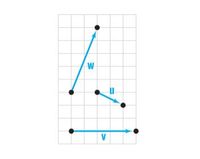
Calculus: Early Transcendentals
8th Edition
ISBN: 9781285741550
Author: James Stewart
Publisher: Cengage Learning
expand_more
expand_more
format_list_bulleted
Question
In Problem ,use the

Transcribed Image Text:V
w/
Expert Solution
This question has been solved!
Explore an expertly crafted, step-by-step solution for a thorough understanding of key concepts.
This is a popular solution
Trending nowThis is a popular solution!
Step by stepSolved in 2 steps with 2 images

Knowledge Booster
Learn more about
Need a deep-dive on the concept behind this application? Look no further. Learn more about this topic, calculus and related others by exploring similar questions and additional content below.Similar questions
- You are given the following three vectorsa = (9 -3 -1) T b = (2 0 2) T c = (-4 0 8) T Find the following vectors: 7a – 4b + 3c.arrow_forwardDetermine which of the following vectors are orthogonal to each other: 12 2 X = -5 3 X2 = |1 X3 = |-3 3arrow_forwardFind the equation of the line L that passes throught point P ( – 4, 3, 7) and Q( – 8, 1, − 5). Enter your answers as vectors. r(t) = + t There are two possibles answers: or Show me your work how you can have either one of the answers by using a math editor or uploading the image of your work.arrow_forward
- Place the vectors a, b, c, and d in order of length, from smallest to largest. Show your calculations in detail. a = (2–√2 ,3 ) b = (5, –2) – (2,–1) c = (3, 2) d = (–2)(-1,2–√2)arrow_forward-0-0 and V For the two vectors: U find the result of the expression: cijkuivjekarrow_forwardFind the angle -4 4. and x between the vectors 2. 2.arrow_forward
- Find the image of the vector = (1, 2) by rotating it 30° counter-clockwise and scaling it by a factor of 4. Select all answers that are correct. O 2sqrt(3)-4 is the first component O 2+4sqrt(3) is the second component O 2sqrt(3)-4 is the second component O 2+4sqrt(3) is the first component none of these abovearrow_forwardFour vectors are shown in the figure below. +y4 Ĉ Ď A +x a. Which of the resultant vectors listed below comes closest to lying along the x axis? OC+ B OÃ+ Ď OD+C b. Is the component of your answer in part a positive or negative? Positive Negativearrow_forwardQ.6arrow_forward
arrow_back_ios
SEE MORE QUESTIONS
arrow_forward_ios
Recommended textbooks for you
 Calculus: Early TranscendentalsCalculusISBN:9781285741550Author:James StewartPublisher:Cengage Learning
Calculus: Early TranscendentalsCalculusISBN:9781285741550Author:James StewartPublisher:Cengage Learning Thomas' Calculus (14th Edition)CalculusISBN:9780134438986Author:Joel R. Hass, Christopher E. Heil, Maurice D. WeirPublisher:PEARSON
Thomas' Calculus (14th Edition)CalculusISBN:9780134438986Author:Joel R. Hass, Christopher E. Heil, Maurice D. WeirPublisher:PEARSON Calculus: Early Transcendentals (3rd Edition)CalculusISBN:9780134763644Author:William L. Briggs, Lyle Cochran, Bernard Gillett, Eric SchulzPublisher:PEARSON
Calculus: Early Transcendentals (3rd Edition)CalculusISBN:9780134763644Author:William L. Briggs, Lyle Cochran, Bernard Gillett, Eric SchulzPublisher:PEARSON Calculus: Early TranscendentalsCalculusISBN:9781319050740Author:Jon Rogawski, Colin Adams, Robert FranzosaPublisher:W. H. Freeman
Calculus: Early TranscendentalsCalculusISBN:9781319050740Author:Jon Rogawski, Colin Adams, Robert FranzosaPublisher:W. H. Freeman
 Calculus: Early Transcendental FunctionsCalculusISBN:9781337552516Author:Ron Larson, Bruce H. EdwardsPublisher:Cengage Learning
Calculus: Early Transcendental FunctionsCalculusISBN:9781337552516Author:Ron Larson, Bruce H. EdwardsPublisher:Cengage Learning

Calculus: Early Transcendentals
Calculus
ISBN:9781285741550
Author:James Stewart
Publisher:Cengage Learning

Thomas' Calculus (14th Edition)
Calculus
ISBN:9780134438986
Author:Joel R. Hass, Christopher E. Heil, Maurice D. Weir
Publisher:PEARSON

Calculus: Early Transcendentals (3rd Edition)
Calculus
ISBN:9780134763644
Author:William L. Briggs, Lyle Cochran, Bernard Gillett, Eric Schulz
Publisher:PEARSON

Calculus: Early Transcendentals
Calculus
ISBN:9781319050740
Author:Jon Rogawski, Colin Adams, Robert Franzosa
Publisher:W. H. Freeman


Calculus: Early Transcendental Functions
Calculus
ISBN:9781337552516
Author:Ron Larson, Bruce H. Edwards
Publisher:Cengage Learning